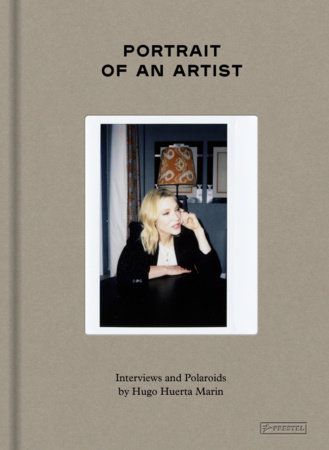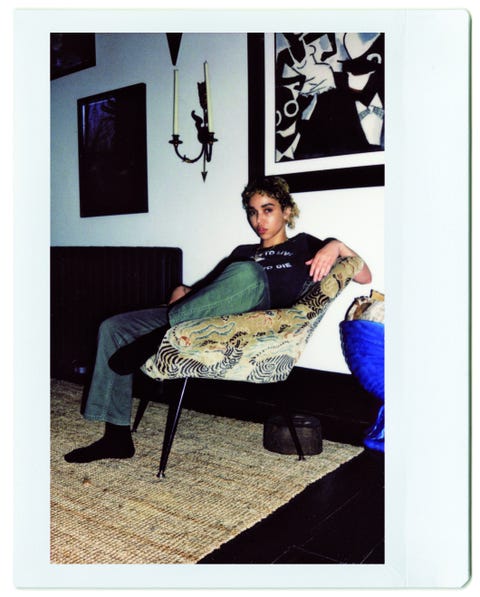Products You May Like
In Portrait of an Artist: Conversations with Trailblazing Creative Women (Prestel), artist Hugo Huerto Marin couples intimate Polaroid portraits with interviews of 30 of the world’s most fascinating women. Below, an excerpt from the book of a conversation between Marin and singer FKA Twigs.
Hugo Huerta Marin: You have used a wide range of dance styles, from pole dancing to voguing, wushu, and krumping. Which kind of corporeal method speaks to you best?
FKA Twigs: That’s difficult. I love them all. And I just like being around people who do them. I have not vogued in a while, though, and it’s not because I don’t love it: It’s because I’m not spending that much time in New York. When I’m in New York I love hanging out with my friends who vogue, and I completely immerse myself in that world, because it is so authentic. I find that when I am not in New York and I try to do it, it feels forced. I tend to do things depending on where I am in the world … I just love learning and being involved in culture, and so I sacrifice the time to do it, because time is the most precious thing — the one thing we are all running out of. I love that conscious sacrifice to learn something. I find that so sexy … To be around something because you enjoy it, that is beautiful.
HHM: How did you first discover the ball scene?
FT: In a weird way. I started voguing when I was about twelve, and I used to make my own voguing routines. I only had a couple of videos, but I didn’t really know what I was watching. One of my uncles used to vogue, so he would teach me some voguing moves. But I didn’t know what it was, you know, I was a kid — I just knew it was a dance, a style, but I didn’t really understand the roots of it. Then, when I was making my album in New York around 2012, I was hanging out with Arca and Shayne [Oliver] from Hood by Air, and I think maybe Arca was the one that took me to Escuelita for the first time, and I completely fell in love with it. There, I met a dancer called Derek Prodigy, who offered to teach me how to vogue, and they just took me under their wing straight away. I wasn’t a well-known singer back then, I was just a girl from London, and they just … I don’t know, I liked them, and they liked me, and I went on to meet some amazing people.
So, I started training with Derek Prodigy and then with Alex Mugler, and it took me a really long time to find out what style was mine, and to be honest with you, voguing is some- thing I’m still not very good at. I would say that I feel insecure, and the reason I feel insecure is because I’m not in New York enough. To me voguing is not just a dance class, it’s not just practicing at home; to me it is matching with someone in the ballroom and really understandng what that scene is. I think that is why I love being in New York so much, because I just feel the most authentic when I am there and doing it. So, I don’t know, I just like to try and find …
HHM: The soul of things?
FT: Exactly, the soul. I mean, I love wushu and I haven’t been to China yet, but I learned from people that are really legit within the wushu community. My first teacher, Master Hu, choreographed the Chinese Olympics and was in films with Bruce Lee — you can’t get more legit than that — so, I don’t know, I just like to immerse myself in culture, even if that sounds a bit naive.
HHM: I think it’s true. I am not a big fan of electronic music, but whenever I go to Berlin and visit the Berghain and experience the core of electronic music, it just sort of permeates your spirit …
FT: Definitely.
HHM: So, voguing uses corporeal language as a formal structure, and has always been a form of resistance.
FT: Yeah.
HHM: And it had a huge comeback in recent years. Do you think that it will bring to light other issues, like it did back then? Or will it put on blast how little things have changed for trans women of color or queer people of color, specifically?
FT: I think it is a really difficult subject to comment on … Because even if voguing is part of queer culture, I feel that people outside that community are seeing only one side of it, the performative side. Voguing is painful but it’s a very beautiful side of that culture, so I don’t know if voguing is directly helping the gay, trans, or queer community … What about when voguers go home? What about where that trans woman is living? What about where the people within the community are working? Are they safe? You know, somebody that’s not part of the community can’t really understand these things by merely watching someone voguing. To be honest with you, I feel the same way about the Black community, in terms of how non-Black people often experience Black people only through entertainment, through dance, music, or sports. It is almost patronizing and uninformed just to engage with one side of a culture … My point is that it is a double-edged sword. I would say that I’m an ally to the queer community, or would like to think of myself as such, but it’s hard to talk about specific issues that I am not a direct part of. I guess I can speak as a minority, as a woman of color … So, let’s put it like this: I think that people who aren’t them- selves a minority — who do not find themselves in a sector of society that is oppressed or misunderstood — can be problematic when they only experience minorities through entertainment and sports. I just feel those things are not painting a true picture.
HHM: Absolutely. It reminds me of the talk I had with artist Carrie Mae Weems, where she said that nowadays there is a kind of shift in the thinking of culture, but the thinking isn’t complex, it’s reactionary. Sort of including Black or brown people in cultural projects … But the question is more, can we get you in? Rather than: What is the structure of your contribution?
FT: First of all, Carrie Mae Weems is my favorite artist. Let’s reference the work of Carrie Mae Weems — this is a very, very private conversation that I have had with myself many times.
HHM: OK.
FT: I went to see Carrie Mae Weems’ work at Tate a couple of years ago, and she had an exhibition where there were different pictures of Black people with a title underneath — “cook,” or “house,” or “field” — and there was a picture of a lighter-skinned Black woman in a beautiful Marilyn Monroe satin dress surrounded by white men, and underneath the picture it said “accomplice,” and that image hit me so hard, so, so hard … I got very emotional and I had to really take a step back and think of what that meant to me. I mean, as a dark-skinned woman, I can say that to get where I am now hasn’t been easy. My stepdad sat me down at a very young age — I was seven or eight — and he said to me: “Because of the color of your skin, you are gonna have to work twice as hard as the white girl next to you, and if you wanna win, you have to be twice as good as the white girl next to you.” And as I get older and people ask me: “Twigs, you are such a good dancer, how are you so good?” the truth is that I know I am good because I’m insecure … because I knew that — especially when I was younger — I had to be twice as good to get out of my situation from a working-class family. You know, I grew up on benefits, I grew up with the government providing money for food, for my college education. I grew up rich in love, but poor financially. We were really poor at times, and for me to get out of that position, I had to train harder … Twice as hard. Even now, at my age, inside I still feel that I am constantly in survival mode, and honestly, sometimes it’s exhausting. But don’t get it twisted, I know that I am lucky, and I know that all I ever wanted in life was to have a stable roof above my head, and now I am lucky that I have one. My point is that I need to stay focused and know where I am standing, and when I saw that Carrie Mae Weems’ photograph it was kind of a reminder, because I don’t want to be that, I don’t want to be an accomplice to anything problematic, and I have to think about that all the time, about what I’m doing, because I know where I come from, and I know my roots and I know how hard I had to work … I don’t know exactly what it means, but I do know that that picture is always in the back of my mind.
Hugo Huerta Marin is the author of Portrait of an Artist: Conversations with Trailblazing Creative Women (Prestel), from which this is excerpted.
This content is created and maintained by a third party, and imported onto this page to help users provide their email addresses. You may be able to find more information about this and similar content at piano.io


